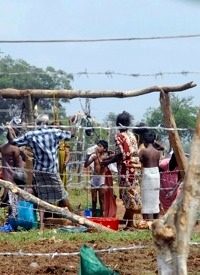
The Agence France-Presse (AFP) reports that “Sri Lanka on Wednesday freed nearly 600 Hindu and Catholic priests who were held in internment camps with ethnic Tamils displaced by fighting between troops and separatist rebels, officials said. The clergy were allowed to leave the camps in the northern district of Vavuniya, where 300,000 inmates are detained under tight security to be screened for remaining Tamil Tiger rebels.”
For generations, Sri Lanka (formally, “the Democratic Socialist Republic of Sri Lanka”) has suffered profound divisions over language and religion. For example, the Sinhalese majority passed the Official Language Act in 1956, which made it extremely difficult for the Tamil minority to remain employed. Religious differences have also divided the primarily-Buddhist Sinhalese from the primarily Hindu and Islamic Tamil portion of the population.
The conflict has periodically manifested in civil war since 1983, as the Liberation Tigers of Tamil Eelam have sought to carve out a Tamil nation in northern Sri Lanka. Approximately 80,000 people have been killed in course of the civil war.
The Tamil Tigers finally conceded defeat on May 17 of this year, but the after effects of the war continue — as the unimaginable figure of 300,000 “inmates” in a nation of only 21.3 million readily testifies. As the AFP report notes, “International and local rights groups have expressed concern about the welfare of the civilians held in the cramped internment centres, which are officially described as ‘welfare villages.’” Such concerns are only heightened by a ban of foreign monitors and independent media to observe the living conditions of detainees.
Human Rights Watch notes both the unspeakable brutality of the Tamil Tigers throughout their civil war, and also the casual disregard for human life which the Sri Lankan government has often displayed, and which can now be seen in the post-war “welfare villages”:
The government claims it needs time to filter out LTTE members who may have escaped with the civilians. At least 10,000 alleged LTTE fighters are believed to have been removed from the camps and separately detained. Only a few thousand of the displaced have been released and allowed to return home or to stay elsewhere. … Humanitarian organisations have long advocated the release of the displaced from the camps; they have been ignored….
Now heavy rains have led to flooding in the sprawling camps, unnecessarily putting camp residents at risk. Oddly, the minister of resettlement and disaster management told the Sri Lankan Daily Mirror that he held United Nations agencies responsible for the flooded camps, saying "(The) Government cannot be blamed for the poor condition of the drainage systems which burst and failed."
This evasion of responsibility is not surprising. The Sri Lankan government had first refused to admit that the civilians being held hostage by the LTTE numbered several hundred thousand, instead making claims that only a few were at risk from the heavy fighting. Then the government insisted that it was respecting its self-declared no-fire safe zone to protect civilians. But satellite images and accounts by witnesses made it clear that civilians instead suffered a continual barrage of military shelling. The Sri Lankan government also claimed that hardly any civilians had died in the final weeks of the fighting; but United Nations figures and personal accounts indicate that several thousand were killed. Some government officials still make the ludicrous claim that the not a single civilian was killed by the Sri Lankan army. (See War on the Displaced: Sri Lankan Army and LTTE Abuses against Civilians in the Vanni, Human Rights Watch, February 2009.)
In a world which has grown used to Orwellian doublespeak, the record of the Sri Lankan government is perhaps not all that shocking. Nevertheless, the plight of several hundred thousand people whose only "crime" was living in a war zone and being, on occasion, shot at by both sides, is appalling. And the imprisonment of Christians in the aftermath of a war conducted primarily along ethnic-religious lines between Buddhist Sinhalese and Hindu Tamils seems absurd.
Which brings us to the high-profile release of several hundred priests. The overwhelming number of priests released on Wednesday are Hindu; according to the AFP account, “A total of 571 Hindu priests, six Catholic priests and two nuns were allowed out … another 220 were still in the camps.”
Clearly, by the standards of the Sri Lankan government, these individuals have been exonerated of any involvement with the Tamil Tigers. What must be remember is that although the Sri Lankan government may be hoping to gather international goodwill by freeing the clergy, they constitute a vanishingly-small percentage of those who are presently being held. AFP reports, “The government promised UN Secretary-General Ban Ki-moon, who visited the island in May, that 80 percent of the refugees would be returned home before the end of this year.” Given the government’s track record, fulfilling this pledge seems highly doubtful, and in an age which has grown callused to governmentally-sponsored inhuman treatment, the detention of hundreds of thousands of people on the basis of their ethnicity continues.
Photo: AP Images



